| GISdevelopment.net ---> AARS ---> ACRS 2000 ---> Poster Session 2 |
Assessment of crop
productivity for major river basins in asia Using gis and rs data
Shiro OCHI and Shunji
MURAI
Institute of Industrial Science, Univ. of Tokyo
JAPAN
E-mail: ochi@iis.u-tokyo.ac.jp , murai@rs.iis.u-tokyo.ac.jp
Keywords: NPP, Crop production, NDVI, Remote
Sensing, GIS Institute of Industrial Science, Univ. of Tokyo
JAPAN
E-mail: ochi@iis.u-tokyo.ac.jp , murai@rs.iis.u-tokyo.ac.jp
Abstract:
The land use / land cover has been dramatically changed in Asian countries in the last a few decades caused by the population pressure. Generally, the forested lands have been converted to agricultural lands, as well as the productivity has been improved because of irrigation, chemical fertilizer, mechanization and so on. The agricultural production has increased for many years in the region to support the population. However, there arises a doubt that there must exist a limit of sustaining the regional population based on agricultural production. In this study, the estimation of agricultural production reflecting the current land use / land cover in the major river basins in Asia, has been investigated.
The agricultural production is considered to be a part of Net Primary Production(NPP) on the agricultural land. The NPP can be estimated using Photosynthetically Active Radiation(PAR) and NDVI, that can be derived from Satellite data. The distribution of agricultural land can be seen in the land use/land cover map. The NPP on the agricultural land of major river basins in Asia was estimated with these dataset. Moreover, by integrating the result of the agricultural NPP with the statistics of country based crop production, the conversion efficiency of agricultural production from agricultural NPP was made. Finally, per capita productivity is analyzed in the region.
1. Introduction
By the UN announcement, world population reaches 6 billion in October 1999. According to the FAO statistics, the crop production has increased corresponding to the population increase in the last 40 years. However, optimistic forecasting of crop production can not be expected, because there are limit of suitable crop land, limitation of productivity and shortage of water resources. Monitoring, estimating and forecasting crop production are quite important for the management of world, regional or local food demand and supply balance. A method to monitor and estimate per capita productivity using remote sensing data and Geographic Information System(GIS) is applied in this study for the region of major river basins in Asia.
2. Processing flow and data used
Figure-1 shows the flow of data processing in this study. There are three kind of source data. Map data include (1) Digital Elevation Model(DEM), (2) River Network Map and (3) Administration Boundary. Statistical data include (4) Agricultural Production and (5) Population. Satellite Data include (6) Land Cover data, (7) Normalized Vegetation Difference Index(NDVI) and (8) Photosynthesis Active Radiation (PAR) Data.
Crop Land Suitability map is generated using DEM based on information of land altitude and slope gradient. Drainage model was generated using DEM(GTOPO30) and River Network Information. The drainage model can extract catchment area of major rivers in Asia such as Amur river, Yellow river, Yangzhu river, Mekong river, Ganges river and Indus river. And the drainage model has consistent flow direction in each pixel from top stream to the bottom of the river. By using the drainage model, each pixel can be identified where is the catchment of the pixel and where to flow to the down stream(Ochi and Shibasaki, 1999). Net Primary Productivity(NPP) is estimated using NDVI and PAR data(Monteith, 1977).
Crop production analysis is made using administrative boundary, statistics of agricultural production
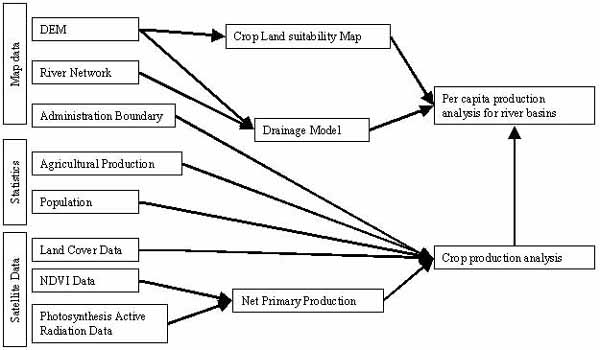
Figure-1 Flow of Data Processing
and population, land cover data and NPP. Finally, per capita crop production analysis is made using crop land suitability map, drainage model and the output of crop production analysis. The detail of the source data is described as follows:
(1) Digital Elevation Model(DEM): GTOPO30, which is 30 second arc resolution(approx. 1km resolution) produced by U.S. Geological Survey(USGS). The data can be downloaded from internet URL : http://edcdaac.usgs.gov/gtopo30/gtopo30.html.
(2) River Network and (3) Administrative boundary map: Rasterized River Network image is generated from Digital Chart of the World(DCW) using ARC/Info - "linegrid" - command. The DCW data can be downloaded from internet URL: http://www.nima.mil/publications/guides/dtf/dcw.html.
(4) Agricultural Production: Agricultural production data is retrieved from FAOSTAT Agricultural Data URL: http://apps.fao.org/. In this study, "cereal production" is used to represent agricultural production.
(5) Population data: CIESIN(Consortium for International Earth Science Information Network) provides 5 minutes population data which were interpolated from the population census in 1994. The CIESIN URL is http://www.ciesin.org/.
(6) Land Cover Data: Land cover data were retrieved from USGS Global Land Cover Characteristics Data Base retrieved at the URL: http://edcwww.cr.usgs.gov/landdaac/glcc/glcc_na.html. There are 6 maps in different schemes in the data base, and IGBP Legend map was used in this study.
(7) NDVI Data: Monthly NDVI data from January 1982 to December 1993 were composed using 8km resolution 10 days composite data set given as NOAA/NASA Pathfinder AVHRR Land Data Set.
(8) PAR Data: One degree monthly Photosynthesis Active Radiation(PAR) data from January 1979 to December 1989 were provided using TOMS satellite data(Dye et al, 1993). In this study, interpolated 8km resolution averaged monthly PAR data were used in order to calculate NPP of 1981 to1989.
3. Methodology and Output
3.1 Estimation of Net Primary Productivity
Monthly Net Primary Productivity(NPP) can be estimated using NDVI and PAR data by "production efficiency approach" proposed by Goward and Huemmrich(1992) and Ruimy, Saugier and Dedien(1994).
NPP:[gDM/m2/time], e : efficiency[g/MJ], ¦APAR:Function of Absorbed PAR [MJ/m2]
e is 1.5 for global average.
The annual total NPP can be estimated as follows:

By using this formula, annual total of Net Primary Productivity(NPP) from 1981 to 1989 was generated. The output was verified using existing study concerning the global NPP and the regional NPP. Table-1 and Table-2 show the comparison of Global NPP versus our study and Regional NPP versus our study respectively(Ochi and Murai,1999). By comparing with other studies, the adopted method in our study for estimation of NPP is acceptable for the purpose of our study goal, though there have been no reference data.
| Model | GNPP(g ton DM/year) |
| Whittaker(1979) | 115.6 |
| Lieth(1977) | 106.0- 125.8 |
| Box(1989) | 122.9 |
| Gotoh(1993) | 110.2 |
| Ochi/ Murai(1999) | 119.4 |
Table-2 Verification of Regional NPP
| NPP(g ton) | |
| Africa | 22.9 |
| North/Centeral America | 19.1 |
| South America | 30.3 |
| Eurasia | 38.6 |
| Oceania | 8.5 |
| Total | 119.4 |
3.2 Correlation between Global NPP and Cereal Production
Figure-2 shows the relationship between Global NPP derived by this study and world Cereal Production prepared by FAO. The correlation factor(R) of the two items is 0.91 in the period from 1982 to 1990. However, the correlation become worse when the data from 1991 to 1993 are involved. It is said that the NDVI data and PAR data include some noise due to the aerosol caused by Mt. Pinatubo Eruption of 1991 therefore the data after the eruption are not adequate for the use. It was found that the NPP can be used for the estimation of crop(or cereal) production.
3.3 Change of NPP in major river basins in Asia
By overlaying USGS/IGBP cover map with global NPP map, NPP from each land cover category can be extracted. Figure-3 shows that changes of NPP from 1982 to 1990 in major six river basins in Asia ; Amur,
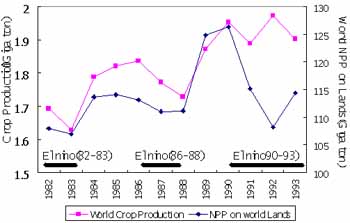
Figure-2 Correlation between NPP and World Crop(Cereal) Production
 |
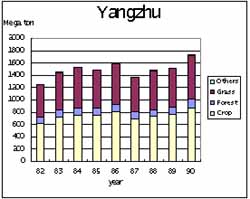 |
 |
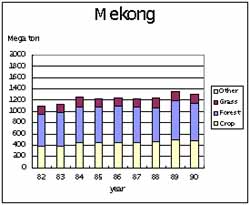 |
 |
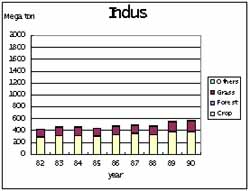 |
Yellow, Yangzhu, Mekong, Ganges and Indus. NPP are mainly produced in the crop and grass land with high population density in the Yangzhu, Yellow, Ganges and Indus river basins. On the contrary, NPP are produced in the forested area in Amur and Mekong river basins where population density is not so high. NPP of crop land are more stable than NPP of other land covers.
Assessment of crop productivity for major river basins in asia Using gis and rs data
4. Analysis and simulation
4.1 Per capita productivity
Per capita productivity is defined for each pixel as follows.
- Catchment area for a pixel along a river is defined using drainage model .
- Accumulated population in the catchment area is calculated for the pixel.
- Accumulated Cropland NPP(CNPP) in the catchment area is calculated for the pixel.
- Per capita productivity is calculated by dividing the accumulated CNPP by the accumulated population for the pixel.
- Per capita productivity is calculated for all pixels of the six major river basins in Asia.
where a: per capita CNPP
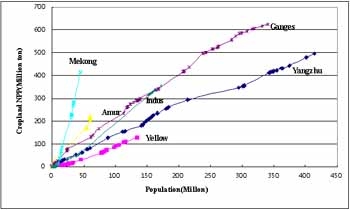
Table-3 Per capita productivity for 6 major river basins in Asia
| Basin | Per capita CNPP(top/cap) | Productivity |
| Mekong | 9.09 | High |
| Amur | 3.46 | Medium |
| Indus | 3.46 | Medium |
| Ganges | 1.93 | Low |
| Yangzhu | 1.22 | Low |
| Yellow | 0.95 | Low |
4.2 Simulation
Carrying capacity based on crop(cereal) production were estimated for these six river basins as shown in Table-4. Cropland areas were measured from USGS/IGBP land cover map for each river basin. Potential cropland was estimated by assuming if a half of existing forested area were converted to cropland. Because the Mekong and Amur river basins remain large amount of forest land, these two basins have more potential of cropland rather than other four basins where most land of the basins are already used for cropland or grassland. "Potential of per capita productivity" means that how many population can be supported by one unit of C-NPP in case one unit of C-NPP can support the same population realized in Yangzhu river basin(820 persons per ton of C-NPP). The current population was measured from CIESIN population data. The output shows that Mekong river basin can support about 13.9 times of the current population in the basin. On the contrary, Yangzhu river and Yellow river basin can support about 1.2 and 1.3 times respectively of the current population in the basins.
| Basin | Cropland area (1000sq.km) | Potential croplan*(%) | Potential of per capita productivity (%) | Current Population(million) | Potential Population(million) | |
| Mekong | 266.1 | 159 | 745 | 45.2 | 535 | (1185%) |
| Amur | 233.3 | 314 | 284 | 60.6 | 540 | (892%) |
| Indus | 370.7 | 101 | 174 | 172.8 | 302 | (175%) |
| Ganges | 638.3 | 104 | 158 | 340.2 | 558 | (164%) |
| Yangzhu | 617.4 | 108 | 100** | 414.2 | 447 | (108%) |
| Yellow | 151.9 | 105 | 77 | 135.2 | 109 | (81%) |
Remarks : * a half of forest land is assumed to be converted to cropland
** per capita CNPP is assumed same as of Yangzhu River Basin
5. Conclusions and Further Studies
In this study, Satellite RS and GIS are used to estimate NPP and Population Capacity in major river basins in Asia. Most of the input data can be down loaded through internet or access-free CD-ROM. The procedure can work to other regions in the world in any scale from local to global, and can be applied using updated satellite data. The result shows that Mekong and Amur River basins have the highest population carrying capacity under the above-mentioned assumptions, while Yangzu and Yellow River basins are saturated. In the previous study about global population carrying capacity, it was not clear how many, where and how people can survive on the land. The output is very useful to understand the future status of the population distribution in the region and to plan the strategy for land use/agricultural development.
There remain some problems to be solved in the procedure. Firstly, in the algorithm to estimate NPP using NDVI and PAR, e(efficiency parameter ) is set to 1.5 as a global average. However, the efficiency is considered to vary depending on the climate condition and vegetation type. Secondly, it was assumed that per capita productivity for all river basins in Asia can attain to the level of Yangzhu river basin in the simulation procedure. However, per capita productivity must have unique value depending on the region specified by the climate, cultivation style etc. The regional characteristics of per capita productivity should be investigated through further studies.
Reference
- Dye, D.G., Goward,S. and Eck, T.F., Global Solar Radiation Data Set for Global Primary Production Studies, Proceedings of SEIKEN SYMPOSIUM-Vol.12 " , pp41-47, 1993.
- Goward, S.N. and Huemmrich, K.F., Vegetation Canopy PAR Absorptance and the Normalized Difference Vegetation Index: An Assessment Using the SAIL Model, Remote Sensing of Environment, 39, pp119-140, 1992.
- Monteith, J.L., Climate and the efficiency of crop production In Britain, Philophical transactions of the Royal Society of London, Ser. B, 281, pp277-294, 1977
- Ochi,S. and Murai, S., , " Analysis of relationship between NPP and Population carrying capacity for major river basins in Asia, Proceedings of 9th SEIKEN Forum "Global Environment Monitoring from Space", pp258-262, 1999.
- Ochi,S, and Shibasaki, R., Algorithm for Generating Drainage Direction Matrix using DEM(GTOPO30) and DCW, Journal of the Japan Society of Photogrammetry and Remote Sensing, Vol38, No.3, pp60-68,1999.
- Ruimy, A., Saugier, B. and Dedien, G., Methodology for the estimation of terrestrial net primary production from remote sensed data, Journal of Geophysical Research, 99, pp5266, 1994.